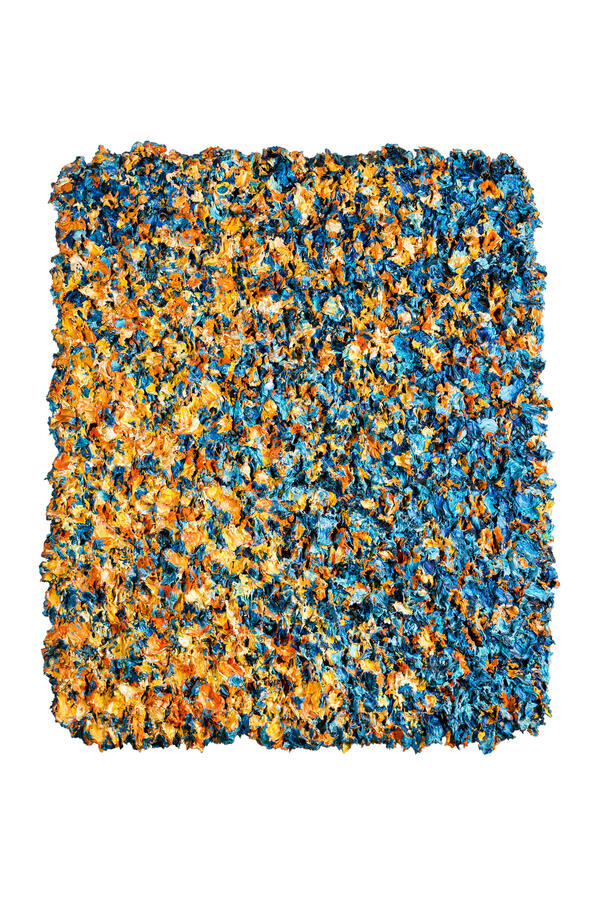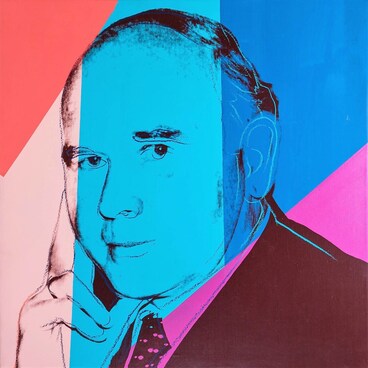“European Volcano” was painted by the German artist Bernd Schwarzer in 1993–1998. He applied layers of thick oil paints onto the canvas to achieve a textured blue and gold surface structure. Schwarzer used various techniques and materials to express his emotions in response to joyful and dramatic events.
According to Schwarzer, the painting’s textured surface represents lava inside a volcano that is about to boil and be expelled. It symbolizes the drastic changes in the life of Europe and the public discussions regarding the region’s future.
Bernd Schwarzer was born in Weimar, East Germany, in 1954. His family managed to move to Düsseldorf, West Germany, before the construction of the Berlin Wall in 1961. Düsseldorf was the center of the new German art where artists often addressed relevant political issues.
In 1976–1984, Bernd Schwarzer studied at Fachhochschule für Kunst und Design in Cologne and Kunstakademie in Düsseldorf. He studied under Werner Schriefers, one of the leading German representatives of Art Informel.
The French term “Art Informel” describes “shapeless art” and refers to various styles of abstract art in post-war Europe.
Since his early works, Schwarzer has made strong political statements through his art, responding to the current events in Germany and abroad. In this way, he carried on the traditions of Joseph Beuys, a German painter and a theorist of postmodernism who combined politics and performance art.
Beuys also inspired Schwarzer to use symbols such as emblems, flags, and natural objects. For example, in one of his works, Bernd Schwarzer used the colors of the flags of Germany and the European Union.
“European Volcano” from the Ludwig Museum’s collection represents Schwarzer’s original technique. He created highly pastose, relief-like paintings. He paid great attention to the tactile qualities of materials. Because of that, his paintings are literally handmade. He would fill his hands with paint and sculpt the painting’s relief — a mountain range or hills with wide crevices.
According to Schwarzer, the painting’s textured surface represents lava inside a volcano that is about to boil and be expelled. It symbolizes the drastic changes in the life of Europe and the public discussions regarding the region’s future.
Bernd Schwarzer was born in Weimar, East Germany, in 1954. His family managed to move to Düsseldorf, West Germany, before the construction of the Berlin Wall in 1961. Düsseldorf was the center of the new German art where artists often addressed relevant political issues.
In 1976–1984, Bernd Schwarzer studied at Fachhochschule für Kunst und Design in Cologne and Kunstakademie in Düsseldorf. He studied under Werner Schriefers, one of the leading German representatives of Art Informel.
The French term “Art Informel” describes “shapeless art” and refers to various styles of abstract art in post-war Europe.
Since his early works, Schwarzer has made strong political statements through his art, responding to the current events in Germany and abroad. In this way, he carried on the traditions of Joseph Beuys, a German painter and a theorist of postmodernism who combined politics and performance art.
Beuys also inspired Schwarzer to use symbols such as emblems, flags, and natural objects. For example, in one of his works, Bernd Schwarzer used the colors of the flags of Germany and the European Union.
“European Volcano” from the Ludwig Museum’s collection represents Schwarzer’s original technique. He created highly pastose, relief-like paintings. He paid great attention to the tactile qualities of materials. Because of that, his paintings are literally handmade. He would fill his hands with paint and sculpt the painting’s relief — a mountain range or hills with wide crevices.



